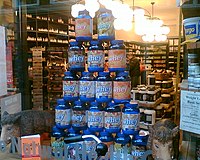
Photo from wikipedia
The integration of phototrophic microalgal production and anaerobic digestion can recycle excess nutrients across European surplus hotspots to produce protein-rich biomass for nutritional applications. However, the challenging physico-chemical properties of… Click to show full abstract
The integration of phototrophic microalgal production and anaerobic digestion can recycle excess nutrients across European surplus hotspots to produce protein-rich biomass for nutritional applications. However, the challenging physico-chemical properties of raw digestate constrain microalgal growth and limit digestate valorization potential. This study focused on the pre-treatment of food waste-based digestate using paper-filtration to improve its properties for cultivating Desmodesmus sp. and Chlorella vulgaris. The microalgal growth performance in paper-filtered digestate (PFD, 10 μm-pore size) was then compared to growth in membrane-filtered digestate (MFD, 0.2 μm-pore size). A microplate-based screening coupled with Cytation device assessment of PFD and MFD samples after dilution and with/without phosphorus supplementation showed that PFD was the best substrate. Moreover, phosphorus supplementation resulted in improved growth at higher digestate concentrations (5-10% v/v PFD), indicating the importance of using a balanced growth medium to increase the volumetric usage of digestate. Results were validated in a 3-L bioreactor at 10% PFD with phosphorus supplementation, reaching a biomass concentration of 2.4 g L-1 with a protein and carbohydrate content of 67% and 13% w/w respectively. This trial indicates that paper-filtration is a promising pre-treatment technique to maximize digestate recycling and deliver a sustainable animal feed-grade protein alternative.
Journal Title: Chemosphere
Year Published: 2021
Link to full text (if available)
Share on Social Media: Sign Up to like & get
recommendations!